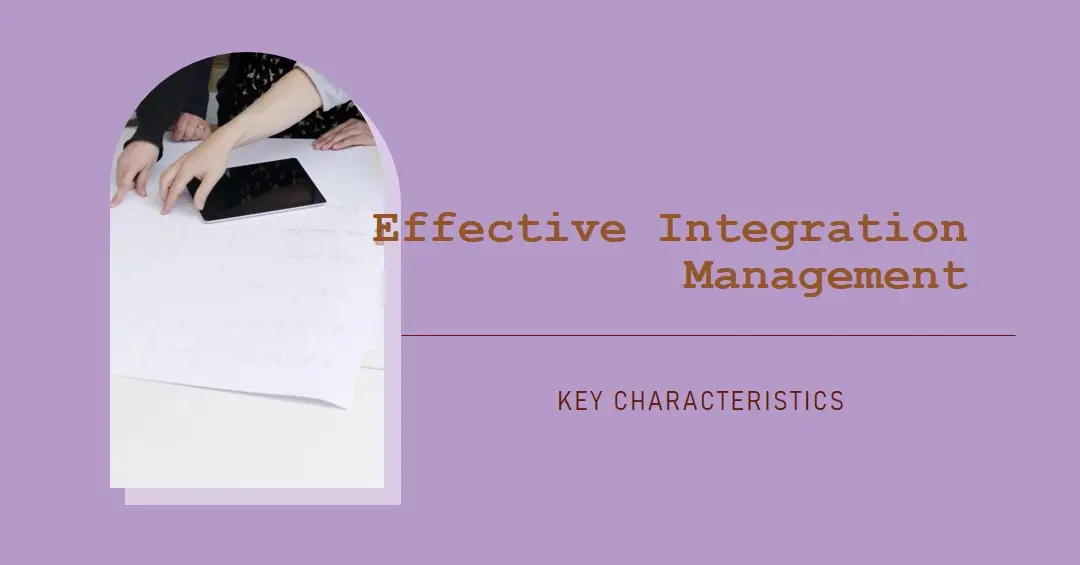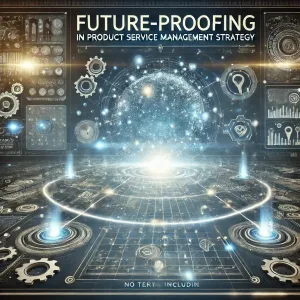I Introduction
In the complex world of project management, the ability to weave together diverse aspects into a cohesive whole is a vital skill. This process, known as integration management, plays a pivotal role in ensuring project success. But what exactly does it entail, and how can you enhance your proficiency in it? This blog aims to answer these questions by delving into the essential characteristics of successful integration management and offering valuable insights on how to cultivate these traits in your own projects.
Integration management is the lynchpin that holds all project components together. It involves coordinating all the elements of a project—people, processes, tools, and tasks—to ensure they function harmoniously towards the achievement of project goals. When executed effectively, integration management ensures that every project piece fits together like a well-oiled machine, creating a synergy that accelerates project success.
In this blog, we’ll not only explore the key characteristics of effective integration management but also provide practical tips on how you can develop these traits. Whether you’re a seasoned project manager looking to sharpen your skills or a newbie eager to learn, this post will equip you with the knowledge and tools necessary to master the art of integration management. So, let’s dive in and unlock the secrets to successful project execution.
Stay tuned as we explore this exciting subject further, and discover how you can become a more effective and efficient project manager.
II Understanding Integration Management
As we navigate the multifaceted landscape of project management, it is paramount to understand what integration management is and why it’s such a crucial component of successful projects. Let’s delve deeper into the concept to fully grasp its essence and its role in project management.
At its core, integration management is a project management discipline that focuses on coordinating all elements of a project. It encompasses everything from aligning project activities to ensuring that the different parts of the project are effectively harmonized. This includes tasks, resources, stakeholders, risks, and everything in between. Simply put, integration management is the conductor in the symphony that is a project, bringing together all the individual instruments to create a harmonious and compelling performance.
The primary role of integration management is to ensure that all project activities are aligned with the project’s objectives and are working towards a common goal. It involves making strategic decisions, managing project changes efficiently, and ensuring that all project components are well-coordinated. In essence, it acts as the glue that binds together all the various project management knowledge areas and processes.
The benefits of effective integration management are numerous. It not only ensures that all aspects of a project are well-coordinated but also allows for smooth and efficient communication among all stakeholders. This leads to better decision-making, improved risk management, and ultimately, a higher chance of project success.
By understanding and embracing the principles of integration management, you can ensure that your projects are not just a collection of disjointed tasks, but a cohesive whole that moves seamlessly towards its objectives. In the upcoming sections, we’ll explore the key characteristics that make integration management truly effective and provide you with practical tips on how to cultivate these traits in your projects. Stay tuned, as we continue our journey towards mastering the art of integration management.
III Key Characteristics of Effective Integration Management
Now that we’ve established a solid understanding of integration management and its importance in successful project execution, let’s delve into the heart of the matter: what does effective integration management look like? Here are the key characteristics that define successful integration management:
Strategic Planning and Execution Strategic planning is the bedrock of integration management. It requires developing a clear vision for the project, defining objectives, and mapping out a strategic plan that guides all project activities. Effective execution of this plan, while maintaining the flexibility to adapt to changing circumstances, is a critical trait of successful integration management.
Effective Communication Effective communication forms the lifeline of any project. It ensures that all stakeholders have a clear understanding of the project objectives, roles, responsibilities, and the status of tasks. In the realm of integration management, communication is not just about disseminating information but also about fostering a culture of openness and transparency.
Coordinated Resource Allocation Integration management requires a holistic view of the project resources. This involves coordinating the allocation of resources (time, money, human resources, materials) to ensure they are used efficiently and effectively, thus maximizing the project value.
Strong Leadership and Decision-making Strong leadership is fundamental in steering the project in the right direction. This involves making informed decisions, resolving conflicts, motivating team members, and ensuring alignment between individual tasks and the overarching project goals.
Risk Management Every project comes with its own set of risks and uncertainties. Effective integration management entails proactive identification, assessment, and mitigation of these risks, ensuring the project stays on track despite any hurdles that may come its way.
Continuous Improvement and Adaptability In the dynamic world of project management, the ability to adapt and learn from experiences is vital. Successful integration management involves continuously improving processes, learning from mistakes, and adapting strategies to suit changing project circumstances.
Stakeholder Engagement Successful projects require the active involvement and support of all stakeholders. Effective integration management ensures that stakeholders are engaged, their expectations are managed, and they are kept informed about project progress.
These characteristics provide a blueprint for successful integration management. In the next section, we’ll offer practical tips on how you can cultivate these traits in your own projects. Buckle up as we continue to navigate the fascinating world of integration management.
IV Cultivating these Characteristics in Your Projects
Having identified the key characteristics of effective integration management, it’s now time to delve into how you can cultivate these traits in your own projects. Let’s break it down and provide some actionable tips for each characteristic:
Strategic Planning and Execution Start with a clear vision of what you want to achieve with your project. Define specific, measurable, achievable, relevant, and time-bound (SMART) objectives, and develop a strategic plan that will guide you towards these goals. Remember, a plan is only as good as its execution, so focus on implementing the plan effectively, while maintaining the flexibility to adapt as circumstances change.
Effective Communication Establish clear communication channels and ensure everyone involved in the project has access to the necessary information. Encourage openness, transparency, and regular updates among team members. Remember, communication is a two-way street, so ensure that you listen to input from your team members and stakeholders.
Coordinated Resource Allocation Develop a comprehensive understanding of all the resources at your disposal. This includes not just financial resources, but also time, human resources, and materials. Prioritize and allocate these resources efficiently and effectively to maximize project value.
Strong Leadership and Decision-making Lead with confidence and make informed decisions. Foster a positive environment, resolve conflicts swiftly, and keep your team motivated. Remember that every decision you make should align with the overall project goals.
Risk Management Identify potential risks early in the project and develop strategies to mitigate them. Regularly review and update your risk management plan to accommodate any new risks that may arise during the project lifecycle.
Continuous Improvement and Adaptability Embrace a culture of continuous learning and improvement. Learn from your past experiences, both successes and failures, and use this knowledge to improve your future projects. Be adaptable and ready to change your strategies when necessary.
Stakeholder Engagement Engage stakeholders from the start of the project. Understand their expectations, keep them informed about project progress, and manage their expectations effectively.
Cultivating these characteristics may seem like a daunting task, but with a little patience and persistence, you can master the art of effective integration management. In the next section, we will illustrate these principles with a real-life example, bringing these concepts to life. Stay tuned as we continue our journey into the fascinating world of integration management.
V Common Challenges and How to Overcome Them
Like any other project management discipline, integration management comes with its share of challenges. However, understanding these hurdles and knowing how to navigate them can significantly increase your chances of project success. Here are some common challenges and tips to overcome them:
1. Managing Complex Projects: Projects, particularly large-scale ones, can be complex, with numerous interdependent tasks, diverse teams, and tight schedules.
Solution: Develop a clear project plan, use project management tools to track progress and dependencies, and encourage regular communication among team members.
2. Coordinating Remote Teams: With remote work becoming increasingly common, coordinating team members across different locations and time zones can be challenging.
Solution: Leverage technology to facilitate communication, use project management software to coordinate tasks, and schedule regular virtual meetings to keep everyone on the same page.
3. Dealing with Scope Creep: Scope creep, where project objectives and requirements expand beyond their original scope, can derail a project.
Solution: Clearly define the project scope at the start, communicate it to all stakeholders, and have a process in place for handling any proposed changes to the scope.
4. Balancing Competing Demands: Projects often involve balancing competing demands, such as quality, cost, and time.
Solution: Prioritize based on project objectives, regularly review progress, and adjust your strategies as necessary to maintain balance.
5. Engaging Stakeholders: Ensuring all stakeholders are engaged and their expectations are managed can be challenging.
Solution: Regularly communicate with stakeholders, keep them informed about project progress, and actively seek their input and feedback.
Navigating these challenges may not be easy, but with effective integration management, they can be effectively managed. In the next section, we’ll recommend some tools and resources that can help you hone your integration management skills. Stay tuned as we continue to unlock the secrets of successful project execution.
VI Tools and Resources for Effective Integration Management
As we continue our exploration into the world of integration management, it’s essential to highlight some tools and resources that can aid in your journey towards effective project execution. These tools can help you plan, manage, and track your projects more efficiently, while the resources can provide additional knowledge and insights. Here are some recommendations:
Project Management Software: Tools like Microsoft Project, Asana, Trello, and Jira can help you manage your projects effectively. These platforms allow you to plan tasks, assign work, track progress, and manage resources all in one place. They also facilitate collaboration and communication among team members.
Communication Tools: Platforms like Slack, Microsoft Teams, and Zoom can enhance communication among project teams, particularly those working remotely. They allow for real-time messaging, video conferencing, and file sharing, fostering a culture of transparency and openness.
Risk Management Tools: Tools like RiskyProject and Risk Register+ are designed to help you identify, assess, and mitigate project risks. They allow you to create a risk register, develop mitigation plans, and track the status of each risk.
Learning Resources: There is a wealth of resources available to help you learn more about integration management. Books like “A Guide to the Project Management Body of Knowledge (PMBOK Guide)” by the Project Management Institute, or online courses from platforms like Coursera, LinkedIn Learning, or Udemy can offer valuable insights.
These tools and resources can be instrumental in your journey towards mastering integration management. Remember, the key to success in integration management, as with any discipline, lies in continuous learning and improvement. Stay tuned for the final section, where we wrap up our exploration into the fascinating world of integration management.
VII Conclusion and Key Takeaways
As we draw our exploration of integration management to a close, let’s recap the key points we’ve discussed:
- Integration management is vital: It is the discipline that coordinates all the elements of a project, ensuring they work harmoniously towards the achievement of project goals.
- Key characteristics of effective integration management: These include strategic planning and execution, effective communication, coordinated resource allocation, strong leadership and decision-making, proactive risk management, continuous improvement and adaptability, and active stakeholder engagement.
- Cultivating these traits in your projects: To cultivate these characteristics in your projects, focus on clear goal-setting, transparent communication, efficient resource allocation, confident leadership, proactive risk management, continuous learning, and stakeholder engagement.
- Overcoming common challenges: Challenges such as managing complex projects, coordinating remote teams, dealing with scope creep, balancing competing demands, and engaging stakeholders can be navigated with strategic planning, effective communication, clear scope definition, prioritization, and active stakeholder communication.
- Leveraging tools and resources: Project management software, communication tools, risk management tools, learning resources, project management blogs, and consultancies can all help improve your integration management skills.
Remember, mastering the art of integration management is not an overnight process. It requires patience, persistence, and a commitment to continuous learning and improvement. But with these traits, you can navigate the complexities of project management, ensuring that your projects are not just a collection of disjointed tasks, but a cohesive whole that moves seamlessly towards its objectives.



